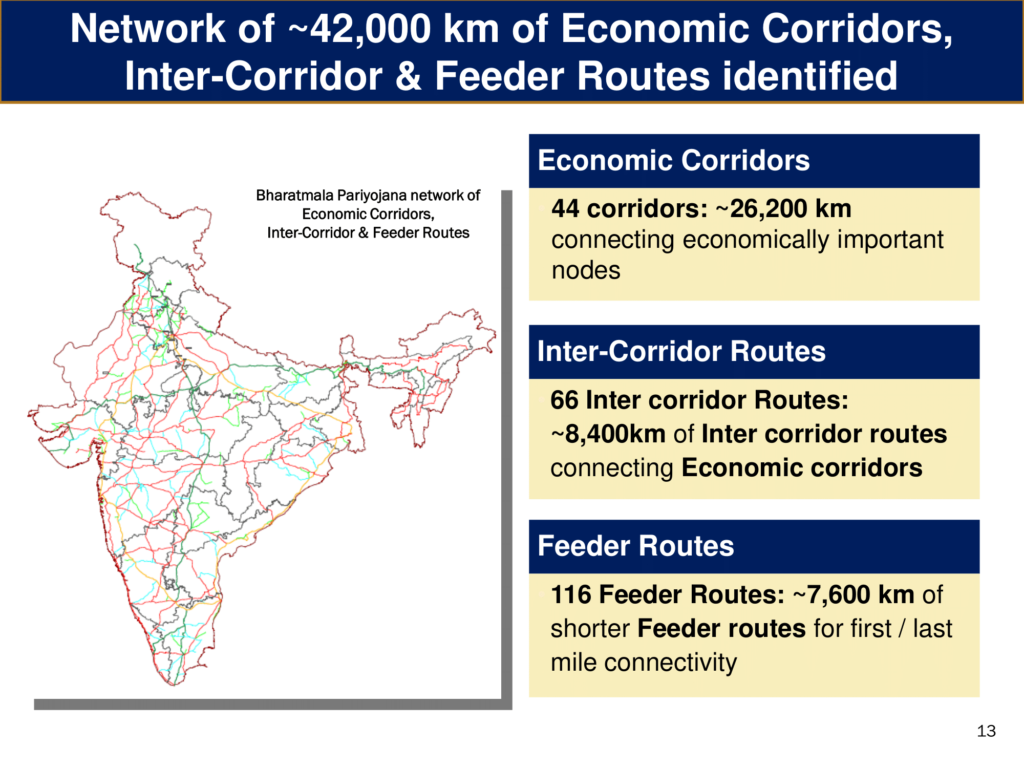Archives
Categories
Major Infrastructure Projects of India
Dedicated Freight Corridor (DFC) Projects: This ambitious initiative involves building high-speed freight corridors to improve efficiency and capacity. Key routes include Delhi-Mumbai and Eastern DFC.
Goal: Dedicated high-speed freight corridors aim to revolutionize cargo movement in India. These dedicated tracks separate freight trains from passenger traffic, significantly increasing efficiency, speed, and capacity.
Key Features:
- Double-stacked container movement for higher capacity.
- Advanced signaling systems for improved safety and efficiency.
- Modern freight terminals with integrated logistics facilities.
- Impact: Reduced transportation costs, faster delivery times, increased trade competitiveness, and decongestion of passenger railway lines.
Bharatmala Project: This massive undertaking aims to develop a pan-India network of highways, including expressways, inter corridors, and feeder roads, to improve connectivity across the country.
Vision: This colossal undertaking aspires to create a comprehensive road network spanning India. It encompasses:
- Expressways: High-speed, controlled-access highways connecting major cities.
- Inter-Corridors: Connecting major industrial hubs and agricultural centers.
- Feeder Roads: Providing last-mile connectivity to rural areas.
- Benefits: Improved connectivity between cities and production centers, reduced travel times, and boosted economic activity in remote regions.
- Challenges: Land acquisition, environmental impact assessments, and ensuring efficient project execution across various states.
Sagarmala Project: This program focuses on developing India’s coastline and waterways. It includes modernizing ports, creating new coastal highways, and promoting inland water transport.
Focus: Unlocking India’s maritime potential by:
- Modernizing Ports: Upgrading existing ports and developing new ones for efficient cargo handling.
- Coastal Highways: Building new highways along the coastline to improve connectivity between ports and industrial centers.
- Inland Waterways: Utilizing rivers and canals for cost-effective cargo movement.
- Coastal Tourism: Developing coastal areas for tourism infrastructure and promoting sustainable coastal development.
- Significance: Stimulating trade, creating new job opportunities in coastal regions, and reducing dependence on land-based transportation.
Delhi Mumbai Industrial Corridor (DMIC): DMIC envisions a 1,500 km long industrial zone with smart cities, manufacturing hubs, and infrastructure along the Delhi-Mumbai route.
Ambition: This 1,500 km long mega-project envisions a future-proof industrial zone along the Delhi-Mumbai route. It incorporates:
- Smart Cities: Developing technologically advanced urban centers with a focus on sustainability and quality of life.
- Manufacturing Hubs: Creating dedicated industrial zones to attract businesses and promote domestic manufacturing.
- Infrastructure Development: Building world-class infrastructure like high-speed rail, logistics parks, and power plants.
- Outcomes: Expected to generate millions of jobs, attract foreign investment, and contribute significantly to India’s industrial growth.

National Highways Development Project (NHDP): This ongoing project focuses on upgrading, widening, and developing a network of national highways across India, aiming to improve transportation across the country.
Legacy Project: This ongoing initiative has been instrumental in upgrading India’s national highway network. It involves:
- Upgrading existing highways: Widening lanes, improving road quality, and enhancing safety features.
- Developing new highways: Connecting previously underserved regions and creating new economic corridors.
- Maintaining highways: Ensuring the long-term usability of the national highway network.
- Impact: Improved connectivity between cities and villages, reduced travel times, and increased movement of goods and people across the country.
Regional Rapid Transit System (RRTS): This project involves building high-speed commuter rail networks in major metropolitan areas like Delhi-Meerut and Delhi-Gurugram to reduce traffic congestion.
Greenfield Airports: Several new international airports are being constructed across India, including Navi Mumbai and Jewar, to cater to growing air traffic and regional development.
Smart Cities Mission: This program aims to develop technologically advanced and sustainable urban centers across India, focusing on areas like waste management, renewable energy, and efficient infrastructure.
Inland Waterways: Inland waterways are being developed to provide an alternative and cost-effective mode of transportation for cargo movement, leveraging rivers and canals.
Digital India: This initiative aims to transform India into a digitally empowered society by improving internet connectivity, promoting e-governance, and fostering digital literacy.
These projects represent a significant investment in India’s future, aiming to boost economic growth, improve connectivity, and enhance the overall quality of life for its citizens. It’s important to note that some projects face challenges like environmental concerns, social displacement, and ensuring equitable development.
